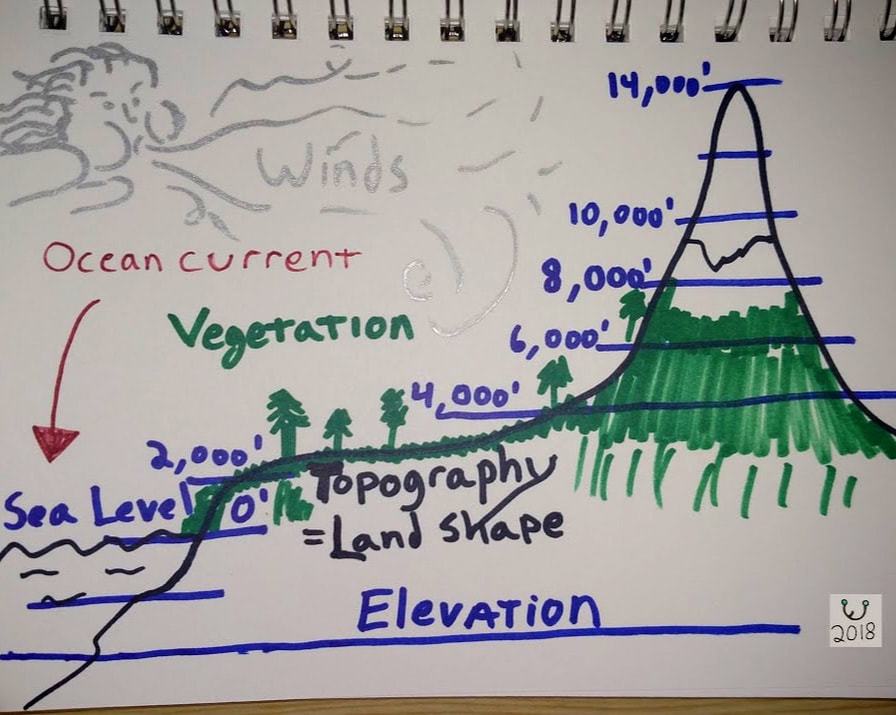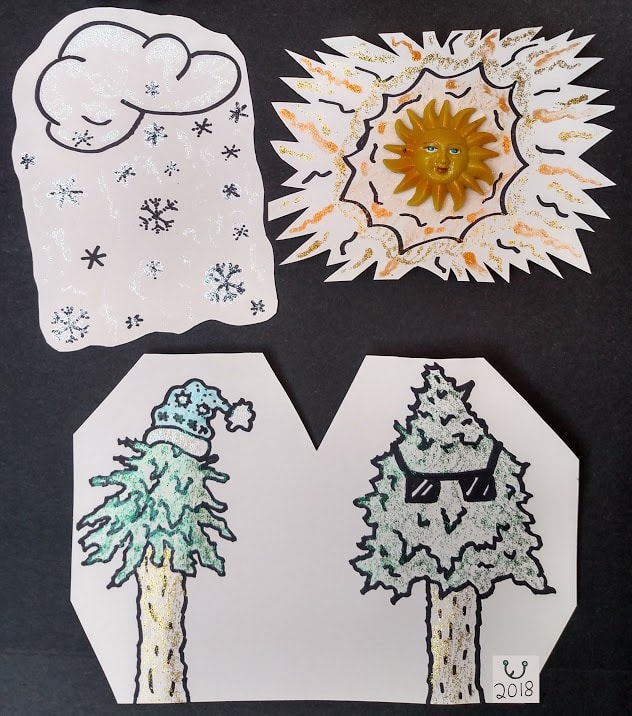Each idea, no matter how well-crafted, is best received when tailored to a narrow, specific audience. All the complicated jargon is great—for those that understand it… But, everyone else WILL glaze over and think about a chocolatey snack, the song stuck in their head, or their to-do list.
I tackled the topic “What is Climate?” for an audience of 11-year-old students for the annual Alan Alda Center for Communicating Science Flame Challenge. Hundreds of scientists participate by submitting their written, video, or graphical answer to the question. Schools across the world receive entries and judge them for what they think are the best answers. Finalists visit New York City to be part of the World Science Festival and meet the M.A.S.H. actor and supporter of science communication–Alan Alda.
Having entered the written challenge in the past (What is Sound and What is Energy) I wanted to try something new: a video. Click here to watch along as I talk about my process
Where to start?
What would an 11-year-old want to see? What can they relate to? What do they already know? And most importantly, what will hold their interest?
Luckily for me, the topic “what is climate?” was announced right before I was about to embark on a journey to the arctic north of Sweden. I knew I wanted to use visuals the kids will likely not have seen before—Arctic snow. But how could I anchor that to climate in a way they can understand?
My friend, who completed her doctoral work studying Arctic and Antarctic ecology, taught me lots about my upcoming travel destination. What stuck with me was that Arctic trees are smaller, better suited for the harsh conditions. I thought how different Arctic trees are from the California Giant Sequoias…and thus I had a storyline. My anchor was literally rooted in the ground!
I wanted to capture the stark differences between the Californian and Swedish climates. I figured the imagery would suit kids as well as adults. However, vaguely talking about climate with cool video was not enough.
Time to revise!


After my first version I sent it along to a few select viewers, including a friend who had an 11 year old and 9 year old son. While both kids liked the video, they told their dad in perhaps a premature, savvy tone, “that video was crafted to a younger audience than me.”
Well, I knew I needed to make it more complex. I also knew I needed more visuals to help include all learners. I drew a tree as it may look in both cold snow and the hot sun conditions.
I drew a stepwise illustration of the factors that affect climate, introducing terms on the picture and to the right in the video. That way students that learn with pictures have something, those that like to read can see the list, and auditory learners can listen. When I edited the closed captions, I used ALL CAPITALS to emphasize the terms yet again.
Another big correction I made was, ironically, my terminology. A friend who teaches high school earth science helped me realize that I, myself, was confusing weather with climate. How embarrassing! But better to know now than after publishing it.
After an overhaul, I sent out a new version. This time my feedback was more in-depth. People were a little lost with what I was saying about weather being part of climate. Some also suggested I condense the content, not repeat certain parts as much, and add music.
So, I went back to the editing software, Lightworks, a free program anyone can use to create videos.
Venn diagrams are a great tool for kids to compare topics. I drew more seasons and circles to delineate my more complex topics.

I wanted to include more than just drawings; I have many captivating items around my house, why not use them! “Spring” features a mixture glass flowers, a real flower encased in plastic, and artistic butterfly magnets. “Winter” has a snow man I made when I was 9—thanks ma for randomly sending me that throwback photo earlier in the year!
Once I had the concept down, I first included the trees from earlier in the video, then expanded to the new seasons and their different weather conditions. This introduced the topic that I would use later in the video to show the culmination of years. Again, I was pulling on classroom teaching techniques of introducing an idea before explaining it so when the topic is more fully explained, the viewer already has some familiarity with it.

Fun Fact: Each year in the climate change section of the video was a year I moved from one city to another—ending with the year I was born. This also matches the statement that climate could have changed in my lifetime. The idea stemmed from trying to start with years the kids could remember in their lifetimes (2018, 2015, & 2014 – a.k.a. ages 11, 8, & 7), and then space the years further apart, including the year they were likely born (2006).
Finally, I cannot emphasize what a difference the music made! Music can be downloaded and used for free from YouTube, or FreeMusicArchive.org. To help the music changes match my video, I used Adobe Audition, though free sound editing software like Audacity work, too.
Take-home messages
While creating the video, I knew I wanted people to watch it more than once. I wanted them to learn things the second time they may have missed. I wanted them to focus on the imagery one time, my words another time, and the drawings in yet another viewing.
I figured, if I could keep viewers entertained, I could teach them something new. It’s gotten the attention of children and adults alike. I tried to keep my energy high and slip in facts without viewers having to think about it. In the first version, my main message was “weather and climate are different”. But I also needed to keep the attention of the more advanced 11-year olds. For those who wanted to dig deeper, I hinted at even more factors of climate—like listing the atmospheric gases that play a role in climate change. I went back over some of my key points and left with a little humor, walking my pet tree.
Hopefully I taught the kids something new. I know I learned about climate myself from making the video. I also learned about how to create videos in general; it was my first attempt at a project like this. Checking my main audience was key…as well as fact-checking!
Now, it is up to the students to decide. I encourage you to watch videos about science communication on the Alan Alda Science Communication website to learn about targeting an audience, not using jargon, and keeping the beginning and ending exciting.



Leave a Reply